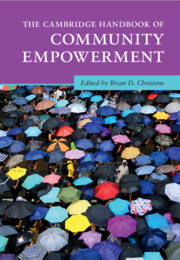Book contents
- The Cambridge Handbook of Community Empowerment
- Cambridge Handbooks in Psychology
- The Cambridge Handbook of Community Empowerment
- Copyright page
- Contents
- Figures
- Tables
- Contributors
- Building Community Power
- Part I Organizing and Activism
- Part II Participatory Governance
- 7 Citizens’ Governance Spaces
- 8 Participatory Budgeting
- 9 Participatory Urban Planning
- 10 Youth Policy Advocacy in Municipal Governance
- Part III Civil Society and Coalitions
- Part IV Enterprise
- Part V Participatory and Community Arts
- Part VI Education and Engaged Research
- Contributor Details
- Index
- References
7 - Citizens’ Governance Spaces
from Part II - Participatory Governance
Published online by Cambridge University Press: 18 April 2024
- The Cambridge Handbook of Community Empowerment
- Cambridge Handbooks in Psychology
- The Cambridge Handbook of Community Empowerment
- Copyright page
- Contents
- Figures
- Tables
- Contributors
- Building Community Power
- Part I Organizing and Activism
- Part II Participatory Governance
- 7 Citizens’ Governance Spaces
- 8 Participatory Budgeting
- 9 Participatory Urban Planning
- 10 Youth Policy Advocacy in Municipal Governance
- Part III Civil Society and Coalitions
- Part IV Enterprise
- Part V Participatory and Community Arts
- Part VI Education and Engaged Research
- Contributor Details
- Index
- References
Summary
This chapter examines practical forms of citizen engagement occurring in collective problem-solving efforts such as civic enterprises, grassroots initiatives, and self-help groups. Drawing empirical evidence from diverse policy fields, it articulates the distinct experimental and disruptive policy work that citizens enact in these citizens’ governance spaces and challenges dominant interpretations that view them as either a testament to the capacity of citizens to effectively solve complex public problems or a symptom of advanced neoliberalism where states off-load complex problems onto citizens. The chapter moves beyond this dualism to consider the motivations, challenges, available resources, and distinct democratic work enacted by citizens in these spaces of bottom-up governance. It also discusses issues of growth and sustainability over time as well as the implications posed for conventional state and civil society institutions. Citizens’ governance spaces offer important lessons – in terms of both potential benefits and risks – for the project of deepening the quality and reach of citizen participation in modern democratic systems.
Keywords
- Type
- Chapter
- Information
- The Cambridge Handbook of Community Empowerment , pp. 193 - 215Publisher: Cambridge University PressPrint publication year: 2024
References
- 1
- Cited by

